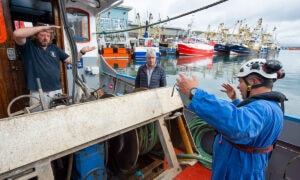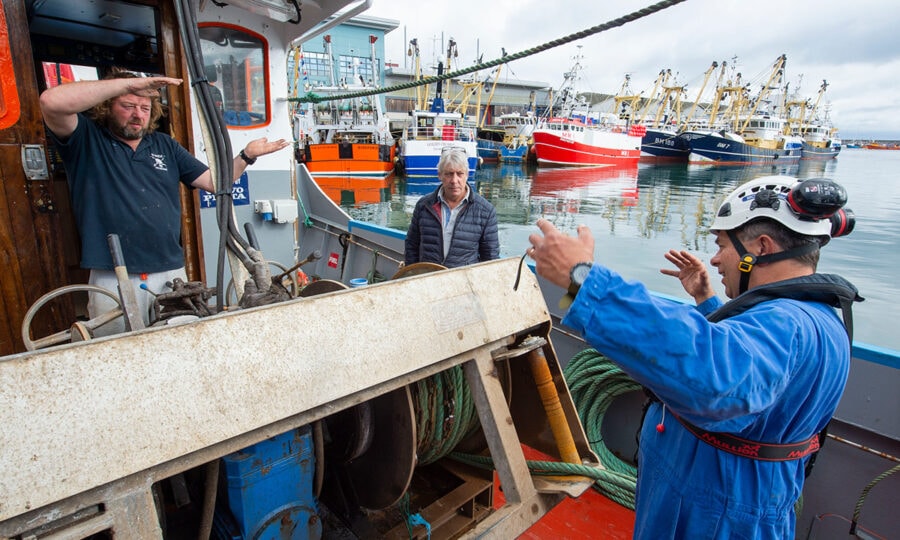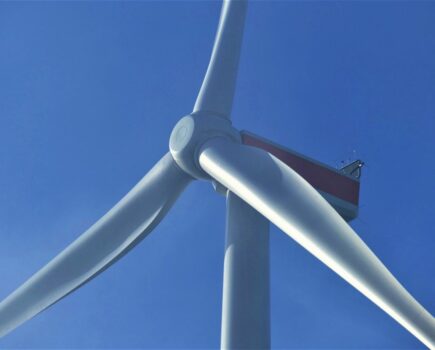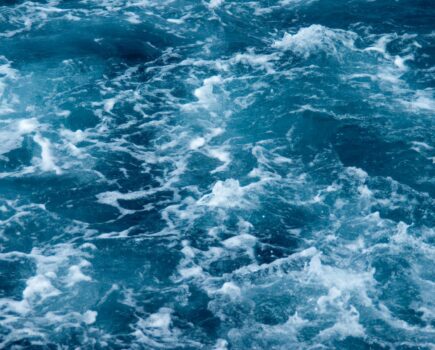In the last of his series of articles, NFFO risk, safety and training lead Charles Blyth offers advice on preparing for your vessel stability assessment, now that the new MCA under-15m safety code is in force
All fishing vessels, irrespective of size, are now required to have a stability assessment, witnessed by the MCA, at least once every five years, or after significant modification. The initial test is likely to be conducted at the same time as your first in-water inspection.
When the new under-15m code was introduced, many vessels were getting tied up due to ‘failing’ a roll test, according to the MCA. Thanks to a sustained effort by the industry, there is now a range of stability assessments which a vessel may undertake, dependant on your hull form and fishing method.

MCA surveyor Roger Gee explaining to Graham Perkes and Garry Roberts, owner and skipper of the 12m Brixham vessel Sue Ellen, how the roll test works. (Photos: Geoffrey Lee)
All tests require the vessel to be in a ‘depart port’ condition. That means fuel and water tanks being topped up, fishing gear onboard ready for use, and any typical spare gear and parts you would normally carry also in place. The MCA is likely to record the quantities and levels of the tanks. This is in order to ensure future tests are done under the same conditions to enable comparison.
It is vital that you check your vessel’s freeboard in a ‘depart port’ condition before booking your test. For decked vessels, if the freeboard of your vessel is less than 300mm, your vessel will be restricted, and if below 200mm, your vessel will be required to be modified by the MCA. If you have been affected by this and are concerned by the modifications imposed, please contact the NFFO, which will be happy to assist.
The different types of stability assessment are:
- Roll test (simplified)
A roll is instigated, and the roll period is timed over several oscillations. The test is passed when the average time for one roll is less than the extreme beam of the vessel. - Roll test (GM method)
The test is similar to the simplified method, but a ‘GM’ (a naval architecture term used to describe the relationship of the centre of gravity and buoyancy) is determined. The vessel will pass the test if the GM calculated from the roll test is more than the minimum required GM based on your vessel’s dimensions. There is a fair amount of maths involved with this test, which the MCA surveyor should be able to assist with. - Heel test (suspended load)
This test will be used for most vessels that lift a weight over the side, such as a beam trawler or scallop dredger. The test involves suspending a typical fishing weight at the highest and/or furthest outboard position and measuring the angle of heel and minimum freeboard. The angle of heel should not exceed 7°, and minimum freeboard in the heeled condition should not be less than 75mm. - Heel test (offset load)
This test involves distributing a defined amount of weight along one side of the vessel at a time, and measuring the angle of heel/ freeboard. The weight is based on 25 x overall length x breadth. You are likely to need defined weights to achieve this. In some instances, the MCA may accept using water in measurable containers to achieve the required weight. This test is most useful for vessels such as stern trawlers, and vessels that fail the roll test. Freeboard in the heeled condition should not be less than 75mm, and the angle of heel should not exceed 15°. - Incline
This is for vessels that already have a stability book, vessels that have undergone major modifications, or change their fishing method to a more dangerous mode, and vessels that fail all other tests. Be warned: incline tests come at great cost, where a naval architect is required. The MCA will also want to approve any information produced. This usually costs thousands of pounds, and the waiting time for approval can be anything from six months to five years.
It is important to speak to the surveyor before the test to make sure you have all the necessary items and provisions in place. As the majority of tests are relatively easy to do, it is a good idea to do a test run to see if your vessel complies or if further work may be required, such as the placement/ removal of ballast or removal of excess spare gear.

Skipper Garry Roberts rocks the vessel so that its roll rate can be measured. Other tests are now available for vessels for which the roll test is not suitable.
If you think that your vessel will struggle to comply, it is critical that you notify the MCA before making any changes. It is also a good idea to consult a marine professional about any intended changes to make sure they are safe and legal.
There have recently been a number of vessels detained by the MCA for carrying out modifications without notification, even if these modifications were intended to improve safety. To make sure you are not caught out, always notify your local marine office of any changes you plan to make.
You will be issued with a Wolfson Unit Stability Notice following the test. This is very useful information, which will determine the limiting sea states your vessel should operate in. These results are based on extensive model testing of small vessels, and it will provide you with a good indication of your vessel’s limitations.
Should you have any concerns regarding the stability of your vessel or which test you will need to undertake, please contact me at: charles@nffo.org.uk and I will be happy to guide you through the new process.
A new short film, funded by The Seafarers’ Charity, with more information on how to get ready for your inspection, can be viewed below…
This story was taken from the latest issue of Fishing News. For more up-to-date and in-depth reports on the UK and Irish commercial fishing sector, subscribe to Fishing News here or buy the latest single issue for just £3.30 here.








